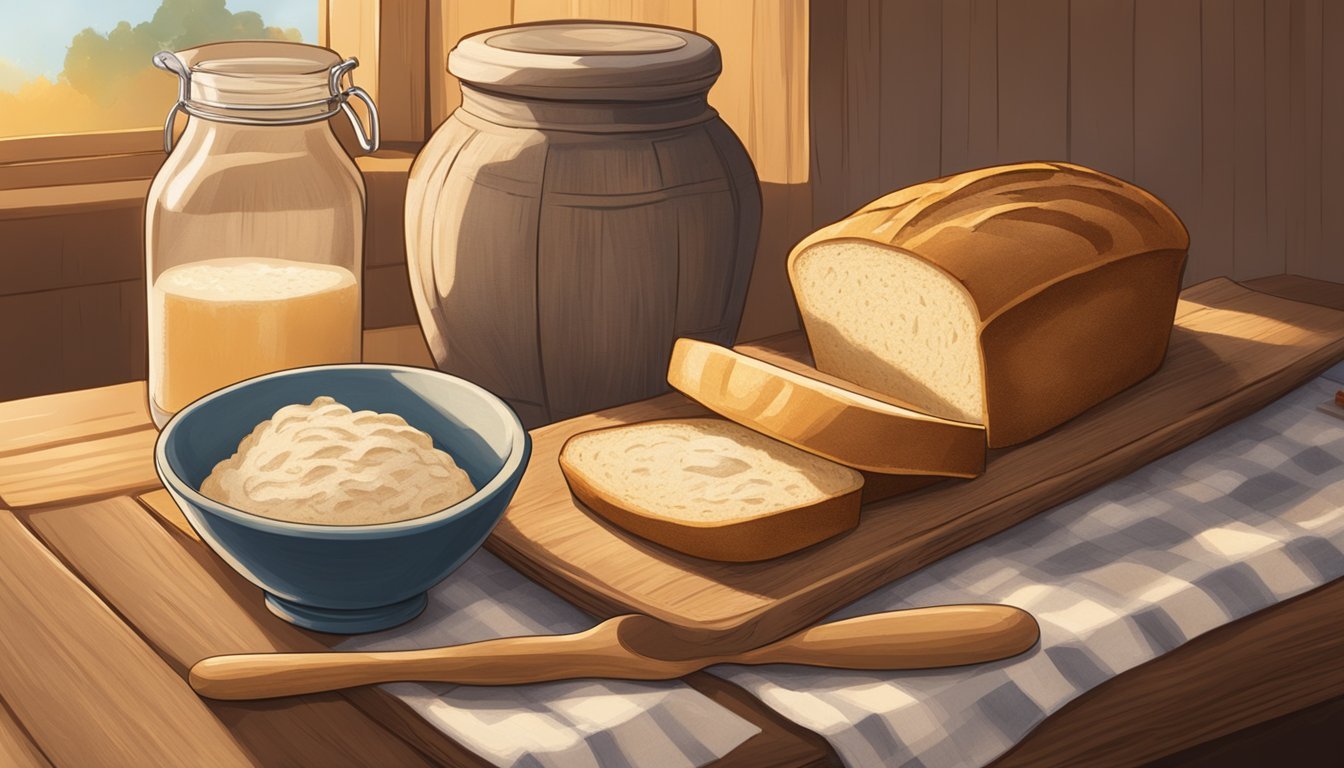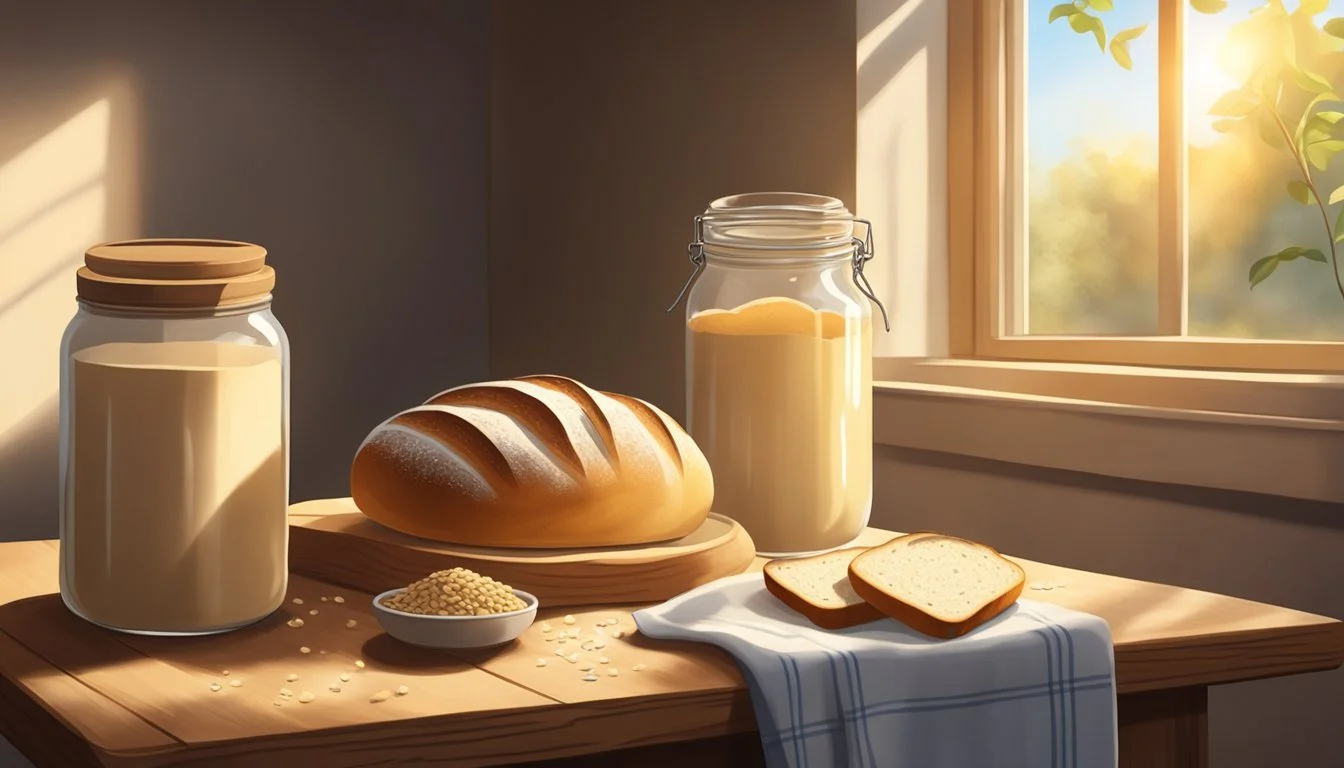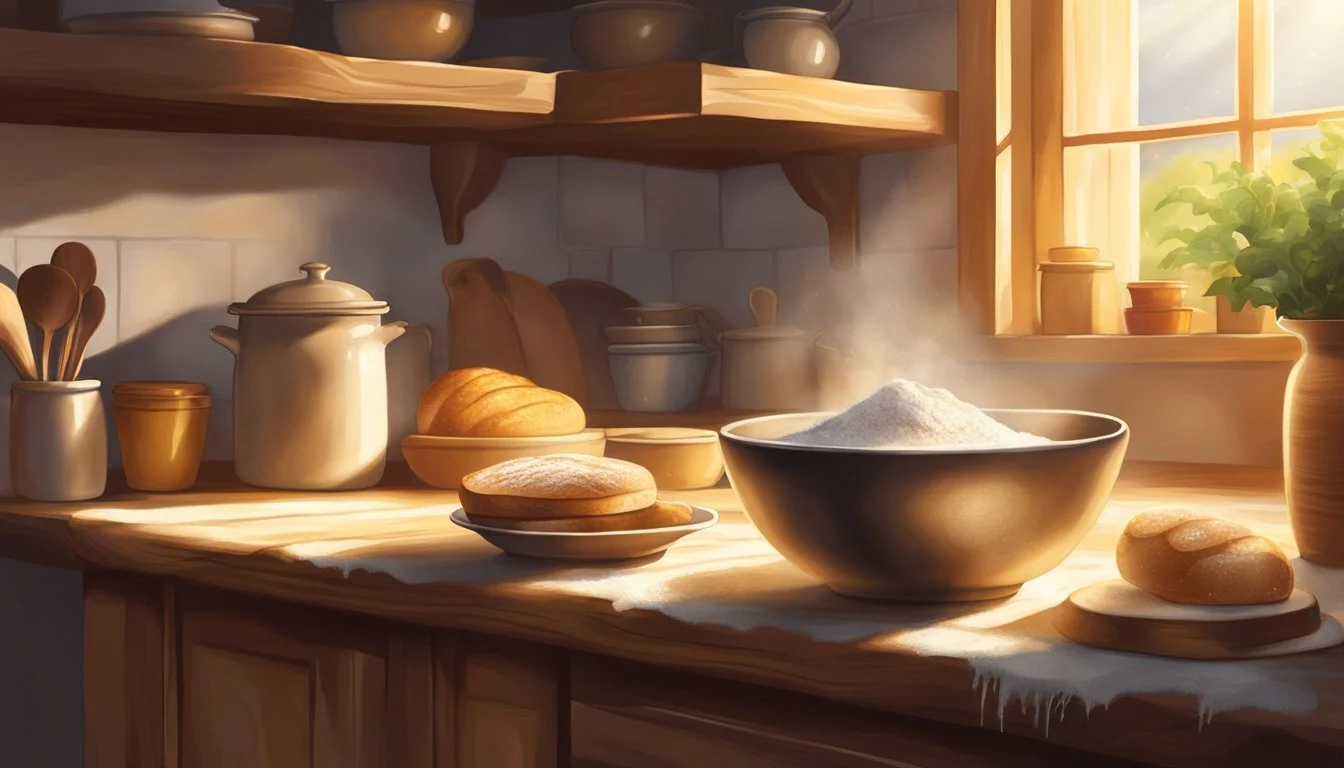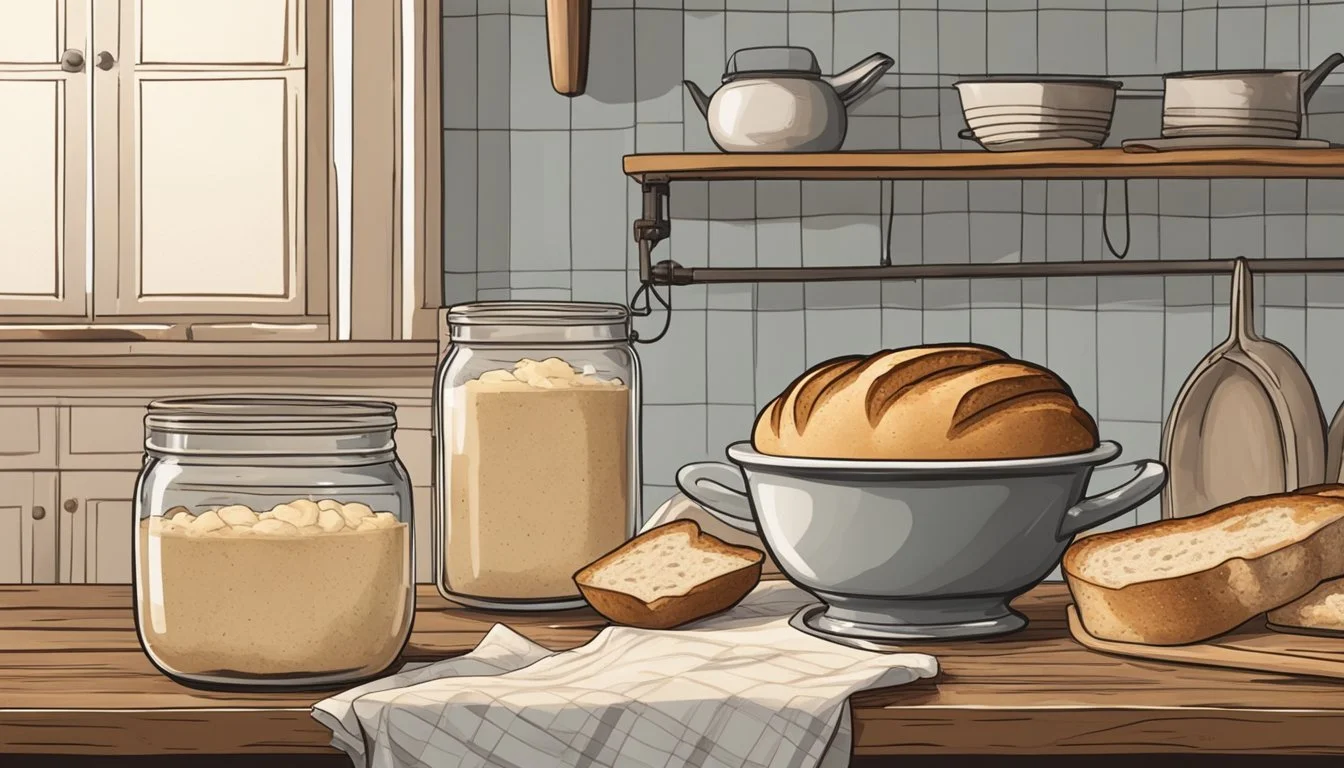Sourdough Baking for the Soul
Embracing Mindfulness Through Artisan Bread Making
Engaging in sourdough baking transcends the simple act of producing a loaf of bread (What wine goes well with bread?)—it is a journey into the art of mindfulness and a practice of meditation. The methodical craft of sourdough baking calls for attention to detail, patience, and a gentle touch, making it not only a culinary endeavor but also a form of therapeutic activity. As bakers mix, knead, and shape their dough, they are invited to immerse themselves in the moment, a practice linked to reduced stress and increased mental clarity.
The slow-paced, sensory experience of sourdough baking encourages practitioners to connect with the tactile joys of bread-making. The sourdough process is unique; it involves fermentation, which demands close attention to the starter, the rise, and the bake times, effectively anchoring the mind to the present. Kneading the dough becomes a rhythmic exercise that can soothe the mind and offer respite from the day's pressures.
Moreover, the satisfaction derived from creating a loaf of sourdough from scratch is immeasurable. Each stage from nurturing the starter to witnessing the dough's transformation in the oven offers a deeply personal and rewarding experience. The artisanal craft of sourdough baking serves not only to feed the body but also to nourish the soul, providing a restorative escape from the hustle of modern life.
The Essence of Sourdough
Sourdough is both an art and a science, deeply rooted in history with a complex fermentation process, driven by a culture of wild yeast and beneficial bacteria.
History of Sourdough
Sourdough bread is one of the oldest forms of grain fermentation. Its origins are ancient, dating back to ancient Egypt around 1500 BC and possibly earlier. Throughout history, sourdough served as the primary bread-making method until it was largely replaced by the use of baker's yeast. Sourdough has been treasured for its robust flavor and resilience, having nourished communities long before modern cooking conveniences.
Sourdough Culture and Starter
A sourdough starter is a mixture of flour and water inhabited by a colony of microorganisms including wild yeast and lactobacilli. This concoction ferments the flour, creating gases and organic acids which cause the bread to rise and develop complex flavors. A healthy starter culture is essential for successful sourdough bread and requires regular feeding to maintain its vitality.
Steps to Create a Sourdough Starter:
Mix equal parts of flour and water in a jar.
Cover with a breathable material, allowing wild yeast to enter.
Feed daily by discarding half the starter and replenishing it with fresh flour and water.
Science of Sourdough Fermentation
Fermentation is the heart of sourdough bread's character. As the sourdough starter matures, wild yeast converts sugars in the flour to carbon dioxide, which creates the airy holes characteristic of sourdough. Lactic acid bacteria, present in the culture, produce organic acids that give sourdough its distinctive tangy flavor. The balance of wild yeast and bacteria, along with fermentation time, temperature, and hydration level, determines the bread's texture and taste.
Key Fermentation Products:
Carbon dioxide: Gas that leavens the dough.
Ethanol: Alcohol that evaporates during baking.
Lactic and acetic acids: Contribute to the bread's flavor profile.
Through the culture and fermentation process, sourdough bread is transformed into a loaf with unique characteristics – a testament to the baking skills that harness the invisible yet powerful forces of biology.
Mindfulness in Baking
In the realm of baking, mindfulness converges with the culinary process to enhance mental health and instill a sense of meditative calm. The act of creating sourdough from scratch serves as a therapeutic practice, embracing the present moment and alleviating stress.
Baking as a Meditative Practice
The practice of baking transcends mere food preparation, evolving into a meditative ritual. The key to meditative baking lies within its inherent rhythm and repetitive motions, such as kneading dough, which can anchor the baker in the here and now. This form of mindfulness allows individuals to focus on the tactile sensations, the aroma of yeast fermenting, and the visual transformation of ingredients, which collectively can induce a state of peace and mental clarity.
Focus Areas in Meditative Baking:
Tactile sensations: Feeling the texture of the dough change under one's hands.
Aromatic awareness: Noticing the subtle changes in scent as ingredients come together.
Visual engagement: Observing the dough rise and take shape.
The Therapeutic Power of Sourdough Baking
Sourdough baking, in particular, offers a unique combination of science and art that can have therapeutic impacts on one's mental health. The slow fermentation process of sourdough requires patience and attention, which encourages bakers to remain present in the moment and can thereby reduce feelings of stress. Moreover, the ritual of measuring, mixing, and shaping fosters a nurturing routine, imbuing a sense of joy and accomplishment.
Mental Health Benefits:
Stress reduction: Engaging in the methodical steps of sourdough baking can soothe the mind.
Sense of achievement: Successfully baking bread brings about a rewarding experience that enhances overall happiness.
Ingredients and Techniques
In the art of sourdough baking, choosing high-quality ingredients and mastering key techniques are pivotal steps toward achieving a perfect loaf. Bakers must pay attention to flour characteristics, hydration levels, and precise mixing and shaping methods to ensure their sourdough offers the best flavor and texture.
Choosing the Right Flour
When selecting flour for sourdough, bakers have a variety of types to consider. High-protein flour is favored for its strong gluten network, essential for trapping gases released during fermentation. A common choice is unbleached bread flour; however, whole wheat or rye flours can be used for a denser crumb and more robust flavor. Gluten-free options are also available and typically require a blend of flours like rice, buckwheat, and tapioca to mimic the texture of gluten-based doughs.
Flour Types:
Unbleached Bread Flour: For strong gluten development
Whole Wheat: For a dense crumb and earthy flavor
Rye: Adds a tangy note to your sourdough
Gluten-Free Blends: Substitute for gluten-intolerant individuals
Hydration and Dough Texture
Hydration, the ratio of water to flour, is critical in determining the dough's final texture. Sourdough typically has higher hydration levels, which create an open crumb and airy texture. Bakers adjust water content according to the flour's absorption capacity, which can vary based on the type and brand of flour used. Precise measurements are key to achieving the desired dough consistency.
Hydration Guide:
Low Hydration (60-65%): Firmer dough, easier to handle
Moderate Hydration (65-75%): Balanced, versatile dough
High Hydration (75-85%): Wet dough, open crumb structure
Mixing and Shaping Techniques
Mixing the dough by hand or with a mixer initiates gluten formation, critical for the dough’s structure. The process starts with combining the ingredients until a rough dough forms, followed by a series of folds or kneads. Bakers develop a feel for when the dough is properly mixed, as gluten development can be overdone.
Shaping is an art that influences the final bake. Proper tension must be created on the dough's surface to maintain its shape and promote even rising. Techniques such as stretching and folding, bench rests, and final shaping are vital to the sourdough's structure. Hands are the baker's most valuable tool here, coaxing the dough into its final form before it heads into the oven.
Mixing Technique:
Combine ingredients until shaggy dough forms.
Fold or knead to develop gluten strength.
Shaping Steps:
Stretch and fold for layering gluten strands
Bench rest for relaxation and extensibility
Final shaping to build surface tension and structure
The Journey of the Dough
Sourdough baking is a transformative experience, taking simple ingredients and melding them through time and skill into a rich, aromatic delight. This journey, from initial mixing to the final golden crust of freshly baked bread, engages bakers in an act of creation that demands both patience and attentiveness.
From Mixing to Fermenting
The initial step in crafting sourdough bread involves combining flour, water, salt, and starter to form the dough. Precision in measurement is critical, as the balance of ingredients influences both flavor and texture. Upon mixing, fermentation begins, slowly developing complex flavors and that distinctive sourdough tang. Bakers watch for signs of life in their dough, gauging fermentation by subtle cues such as volume increase and the presence of bubbles.
Key indicators of sufficient fermentation:
Dough volume increases by approximately 30% to 50%
Visible bubbles on the surface and edges
Sweet, yeasty aroma develops
The Art of Patience in Sourdough Crafting
Patience is a bakers' virtue during the sourdough process. Here, one monitors the subtle interplay of time and biology, allowing the dough to rest and shape its future loaf. In these quiet moments, bakers find satisfaction in the knowledge that patience yields a better crumb—the intricate, porous structure inside the bread. It is a balance of being present and trusting the process that defines the sourdough experience.
Benefits of patience in sourdough crafting:
Developed flavors and aromas
Improved texture and crumb structure
Enhanced dough strength and elasticity
Baking and Cooling: The Final Transformation
The culmination of a bakers' journey is the baking process itself, where dough becomes bread as it enters the heat of the oven. Temperatures soar, crusts crisp, and a sweet aroma fills the air—a reward for the senses and a signal of the loaf's impending readiness. From here, bakers must employ patience once more, allowing bread to cool and set for optimal taste and satisfaction. Cutting into a loaf of freshly baked bread is the final, gratifying step in recognizing the journey's end.
Critical baking milestones:
Oven spring and crust formation
Internal temperature of bread reaches 190-210°F (87-99°C)
Cooling for at least 20 minutes to allow the bread to set
Sourdough for Health and Wellbeing
Exploring the intersection of sourdough bread-making with health and wellbeing unveils two key facets: the nutritional value of sourdough bread and its role in fostering emotional well-being. These elements contribute significantly to both physical and mental health.
Nutritional Benefits of Sourdough Bread
Sourdough bread stands out for its unique fermentation process involving natural bacteria and yeast. This fermentation not only creates its distinct taste but also enhances its nutritional profile. Studies suggest sourdough bread has an improved glycemic index compared to regular bread, which can be beneficial for blood sugar management. The presence of probiotics from the fermentation process supports gut health, a pivotal aspect of overall wellbeing.
Prebiotic Content: Unlike most breads, sourdough contains prebiotics, which nourish the good bacteria in the gut.
Gluten Digestion: For those sensitive to gluten, sourdough's fermentation process may break down some of the gluten, making it easier to digest. However, it is not considered gluten-free and should be avoided by individuals with celiac disease.
Sourdough Baking for Emotional Well-Being
The act of baking sourdough bread can be as nourishing to the mind as the bread is to the body. As bakers mix, knead, and shape their dough, they engage in a mindful practice that can reduce stress and anxiety. The structured yet creative nature of sourdough baking provides a form of meditative therapy, which has been embraced as a calming ritual by many.
Stress Reduction: The repetitive motions of kneading dough are shown to decrease stress levels, offering a tactile method to unwind.
Sense of Accomplishment: Completing the steps to bake a loaf from scratch can instill a sense of achievement, boosting one's mood and emotional well-being.
This blend of physical nourishment and mental clarity positions sourdough bread-making as a fulfilling activity for enhancing one's health and happiness.
Building a Sourdough Community
The art of sourdough baking fosters connections and creates communities bound by the shared passion for traditional bread-making. It is an opportunity to bring individuals together, not just around the smell and taste of fresh bread but around the knowledge and traditions that come with it.
Sharing the Love of Sourdough
Community Growth through Sourdough: Enthusiasts often find joy in sharing their creations with family and friends, which can ignite a communal interest in sourdough baking. Through sharing loaves, starters, and recipes, they form a network of supportive relationships, encouraging each other's efforts in baking while contributing to the spread of sourdough's unique culture.
Family Involvement: Sourdough baking can become a family affair, where recipes and techniques are passed down through generations—strengthening bonds and building traditions.
Community Sharing Platforms: Many home bakers and professionals alike subscribe to online forums, social media groups, and newsletters - sharing successes, troubleshooting failures, and exchanging tips.
Sourdough Schools and Workshops
Educational Engagement: For those looking to improve their craft or learn from scratch, sourdough schools and workshops provide a structured learning environment. Here, attendees can gain hands-on experience under the guidance of seasoned bakers.
Structured Curriculum: Schools usually offer courses that range from beginner to advanced levels, ensuring that every participant leaves with a deeper understanding of sourdough.
Workshop Benefits:
Skill Development: Participants enhance their kneading and shaping techniques, among other skills.
Community Building: Workshops provide a space to meet and form connections with fellow sourdough enthusiasts.
Personal Growth Through Sourdough Baking
Sourdough baking serves as more than just a way to make bread; it's a journey of self-improvement. As bakers measure, mix, and knead, they cultivate patience and confidence while expressing their creativity in the kitchen.
Developing Patience and Mastery
Sourdough baking is not a quick process; it requires bakers to slow down and respect the timetable of natural fermentation. The routine of feeding the starter, waiting for it to peak, and timing the proving encourages bakers to patiently observe and respond to the dough’s needs. This mindful interaction fosters a sense of mastery as one learns to anticipate how variables like temperature and humidity affect the rising bread.
Routine: Building a routine around sourdough baking promotes discipline.
Satisfaction: There is immense satisfaction in watching a dough transform through one’s own efforts.
Mastery: Mastering sourdough techniques imparts a sense of accomplishment, enhancing personal confidence.
Creativity and Confidence in the Kitchen
Starting with the same basic ingredients, individuals have the freedom to shape and style their bread in countless ways. Experimenting with different flours, hydration levels, or additions (such as nuts or dried fruits (What wine goes well with dried fruits?) allows bakers to express their creativity, turning each loaf into a unique work of art. This creative process boosts confidence, as one sees their visions come to life through the bread they create.
Confidence: Each successful loaf builds confidence in one's skills.
Creativity: Creative expression is encouraged through experimentation with flavors and shapes.
By harnessing the methodical nature of sourdough baking, individuals find a pathway to personal growth. Each step in the process can foster internal satisfaction and outward creativity, contributing positively to one’s quality of life.
Integrating Sourdough Into Daily Life
Sourdough baking can become a fulfilling part of one's daily routine, offering balance and a sense of accomplishment. By weaving the art of sourdough into everyday activities and managing baking time efficiently, one can find joy in the kitchen.
Incorporating Baking into Everyday Activities
Sourdough baking is not just about creating bread; it's an exercise in integrating practice with daily life. Individuals can find moments throughout their day to engage with their dough. While a sourdough starter requires attention, it’s flexible enough to fit into various schedules. For example, one can feed their starter or mix their dough while waiting for their morning coffee to brew. With each step of the process, like fermenting or shaping the dough, bakers can align these tasks with activities like reading, laundry, or even working from home. By doing so, they not only multitask but also weave moments of mindfulness into ordinary tasks, transforming the kitchen into a space of meditation.
Morning: Feed the sourdough starter during breakfast.
Midday: Stretch and fold the dough during a work break.
Evening: Score and bake the bread after dinner.
Managing Time: Sourdough and the Clock
The key to incorporating sourdough baking into a busy life lies in understanding that sourdough operates on its own clock, one that is often patient and forgiving. A baker can plan their sourdough baking steps around their life, not the other way around. The initial mixing can be done in minutes, and the bulk of the work—the rise—requires no active engagement, allowing one to focus on other tasks. Here is a brief timeline that one might follow:
Morning
7:00 AM: Mix the starter, flour, and water.
Bulk Fermentation Workday
12:00 PM: Check and perform a set of stretch and folds during a lunch break.
Evening
6:00 PM: Shape the dough after work.
8:00 PM: Preheat the oven.
8:15 PM: Score and bake the bread.
This schedule shows that with a bit of planning, one can bake fresh sourdough bread without disrupting their day-to-day life. By strategically fitting sourdough stages into naturally occurring breaks, the process can adapt to even the most time-constrained routines.
Advanced Sourdough Techniques
In the world of sourdough baking, the pursuit of new flavors and the adaptation of techniques to cater to dietary restrictions like gluten intolerance are pushing the boundaries of traditional recipes. Bakers who master advanced strategies can produce a diverse range of high-quality sourdough breads.
Experimenting with Different Recipes and Flavors
Experimentation in sourdough baking allows one to discover an array of unique tastes and textures. Seasoned bakers often tweak the following variables to enhance their sourdough creations:
Fermentation Time: Longer fermentation can develop deeper flavors.
Flour Types: Combining different flours such as rye, whole wheat, or spelt introduces distinct taste profiles.
Inclusions: Incorporating ingredients like olives, nuts, seeds, or dried fruits can transform a basic loaf into a specialty bread.
Hydration Levels: Adjusting water content affects the dough's consistency and the final crumb structure.
A table to guide flavor experimentation might look like this:
Ingredient Effect on Flavor Suggested Use Rye Flour Earthy, tangy 10-25% of total flour Olive Oil Richness, softness 2-4 tablespoons Walnuts Nutty, crunchy ½ cup, toasted Dried Figs Sweetness, texture ¾ cup, chopped
Mastering Gluten-Free Sourdough Recipes
Creating gluten-free sourdough presents its own set of challenges, requiring bakers to become familiar with alternative flour blends and hydrations levels optimal for gluten-free grains. Essential techniques include:
Flour Blend: One must carefully select and proportion gluten-free flours such as rice, buckwheat, and sorghum to mimic the properties of gluten.
Xanthan Gum or Psyllium Husk: These are often used as binding agents to improve dough structure in the absence of gluten.
Hydration and Mixing: Gluten-free doughs typically require more water and thorough mixing to hydrate the flours and achieve the right consistency.
As such, mastering gluten-free sourdough recipes involves patience and precision, but it allows bakers to offer enjoyable bread options for those with dietary restrictions.
Appreciating the Imperfections
When one engages in sourdough baking, they encounter a process that embraces imperfections. Unlike industrial bread-making, sourdough is an art steeped in variability. Each loaf, with its unique size, shape, and texture, tells a story of the conditions under which it was created.
Relaxation: The act of accepting imperfections can lead to a state of relaxation. Sourdough's unpredictable nature requires bakers to relinquish control, cultivating patience and a serene state of mind.
Comfort: There's comfort in the homey and rustic appearance of a sourdough loaf. Its uneven crust and crumb, far from being flaws, become signs of authenticity and the human touch behind the bread.
Texture: Sourdough's texture is a tapestry of perfection and imperfection. A baker might strive for lightness and holes created by the fermentation process, yet each loaf emerges with a distinctive texture, none exactly replicating another.
The process of baking sourdough teaches that perfection isn't the goal; rather, it is the journey and the lessons learned through handling the dough. Each imperfection is an opportunity to grow and refine one's technique. As the bread rises and bakes, these so-called imperfections contribute to the character of the loaf, making each slice uniquely satisfying. This acceptance of natural variation is pivotal, turning the act of baking into a reflective and mindful practice.
The Art and Science of Sourdough
Sourdough baking is a fine example of how culinary art is underpinned by scientific principles. It is an intricate dance of chemistry and craft that engages the senses and cognitive abilities, requiring a baker to apply both research-based knowledge and intuition.
Understanding the Chemistry Behind Sourdough
Sourdough bread-making starts with a simple mixture of flour and water. Yet, within this mixture lies a complex chemical ecosystem. The sourdough starter—the heart of the process—is a living colony of yeast and bacteria. The yeast consumes the carbohydrates in the flour, producing ethanol and carbon dioxide, which cause the bread to rise. The bacteria, primarily lactic acid bacteria, ferment the dough in a slightly different manner, creating organic acids that lend the bread its distinct tangy flavor.
The ratio of flour to water (hydration) in the starter and dough impacts the fermentation rate and the bread's final texture. A higher hydration generally leads to a more open crumb structure and a crispier crust. The fermentation process is also influenced by the ambient temperature and the specific strains of yeast and bacteria present.
Sourdough Baking as a Scientific Endeavor
Sourdough baking is not just an art; it's a scientific endeavor that involves precision and understanding. Bakers must often use their math skills to adjust recipes, calculating percentages for hydration or scaling ingredients up or down. Baking also requires one to engage their senses—sight, smell, and touch—to gauge when the dough has been sufficiently kneaded and to determine the perfect baking point.
While the artistic aspect of sourdough baking allows for creativity in shaping loaves and scoring patterns, the science behind it is grounded in empirical research. This research has refined our understanding of fermentation and the microbiome of sourdough starters. Additionally, the chemical reactions that occur during baking—like the Maillard reaction that gives the crust its golden color and flavor—are well-documented phenomena that bakers can leverage to create their perfect loaf.
Sourdough Baking as a Lifestyle
Adopting sourdough baking as part of one’s lifestyle not only nurtures the soul but often reflects a commitment to environmental sustainability and personal well-being. It’s a holistic approach that influences one's immediate surroundings and contributes to the broader community ethos.
The Environmental Impact of Baking at Home
Baking sourdough at home offers a more sustainable alternative to store-bought breads. The key factors contributing to its reduced environmental footprint are:
Lower Emissions: Home baking typically results in fewer greenhouse gases per loaf compared to commercial baking, as it cuts out the need for long-distance transportation.
Packaging Reduction: It minimizes the use of plastic and other materials seen in commercially packaged bread.
Moreover, individuals often source local, organic ingredients that support sustainable farming practices, thereby reducing the overall impact on the environment.
Fostering a Sourdough Culture in Your Personal Environment
Creating and maintaining a sourdough culture transcends mere cooking; it's an exercise in patience and connectivity. Aspects that underscore this include:
Mindful Practice: The rhythmic nature of sourdough baking can be meditative, fostering a form of mindfulness that can reduce stress and improve mental clarity.
Community Engagement: Sourdough enthusiasts often share starters, recipes, and techniques, deepening community bonds and preserving the cultural significance of artisanal baking.
By integrating sourdough baking into one’s lifestyle, individuals often find a sense of purpose and joy in the simplicity of the process, which resonates with their motives for a conscious way of living.
Conclusion
Sourdough baking transcends mere culinary practice to become an avenue for enhancing one’s mental health and well-being. The mindful engagement required throughout the baking process fosters a meditative state akin to traditional meditation practices.
Individuals often discover joy in the simple, tactile pleasure of creating sourdough from scratch. The regeneration of the starter culture, the therapeutic rhythms of kneading, and the patience required for the dough to rise, all draw bakers into the present moment. This attentiveness to the task at hand is the essence of mindfulness, which has been linked to reduced stress and increased mental clarity.
The aroma of freshly baked sourdough, the satisfaction of a crust well-formed, and the taste of a slice are sensory experiences that round out the mindful journey. Involvement in such a process has the potential to enrich one’s appreciation for the small wonders of daily life.
Not only does the practice of sourdough baking provide a meditative respite from a fast-paced world, but the act of sharing the fruits of one’s labor can extend the benefits to others, multiplying the joy inherent in the practice. Furthermore, the health benefits of sourdough as a naturally fermented food contribute positively to the physical health of its enthusiasts.
As one integrates sourdough baking into their lifestyle, they embrace a tradition steeped in antiquity that continues to offer contemporary pathways to health and contentment.












